
|
Distribution of Mars in Gauquelin Sectors for Day Charts and Night Charts of Professional Groups Copyright © 2010 All Rights Reserved by David Cochrane In a recent paper I reanalyzed Theodor Landscheidt's findings regarding the distribution of Mars-Saturn angles in the birth charts of scientists as presented by Landscheidt in the May-June, 1998 issue (Vol 40, # 3) of the Astrological Journal published by the Astrological Association of Great Britain (see A Reanalysis of Theodor Landscheidt's Findings). Landscheidt analyzes Mars-Saturn angles and also the distribution of Mars in Gauquelin sectors. In the previous paper a reanalysis of the distribution of Mars-Saturn angles was conducted. In this paper a reanalysis of the distribution of Mars in Gauquelin sectors is conducted. Landscheidt's analysis of Mars in Gauquelin sectors builds upon earlier work by Lee Lehman. Lehman introduced an innovative approach to analyzing Mars in Gauquelin sectors: she distringuish day charts from night charts and analyzed them separately. A day chart is a birth chart during the day, i.e., the Sun is above the horizon, and a night chart is a chart that has the Sun below the horizon. In ancient western astrology day charts and night charts are regarded as being different from each other. Lehman applied this day to the analysis of Gauquelin sectors and Landscheidt reanalyzed Lehman's findings to point out peaks at golden aspects. Landscheidt notes that Lehman produced 12 Gauquelin sectors and he would like to see a finer division into 36 sectors. In the graphing of the data below the results are shown in 120 sectors so that a very detailed look at the distribution of Mars is possible. Landscheidt's graphs of Mars in Gauquelin sectors for professional groups includes arrows pointing to the peaks and a designation of the golden aspect involved. I have assembled the data in these graphs into the following summary of conclusions presented by Landscheidt regarding where peaks in the Gauquelin sectors occur. Data Summary 1.
Note that the numbers in parentheses are moderate highs and lows. For example, painters and musicians have a moderate high at 137.5 and a more pronounced high at 68.8. The results presented in the graphs of sports champions and actors in Landscheidt's paper brought to mind that I had neglected to analyze these professional groups in the previous paper (A Reanalysis of Theodor Landscheidt's Findings). In the previous paper I analyzed six professional groups: scientists, musicians, journalists, politicians, military leaders, and painters. There are three additional professional groups available in the Sirius software that I neglected to analyze: sports champions, writers, and actors. I plan to go back to the previous article and add the analysis for these three additional professional groups. The results for nine professional groups are shown below. The distribution of Sun-Mars angles in 46,257 charts of famous people, companies, and major events and the distribution of Sun-Mars angles daily from 1800 to 1930 is shown in Figure 1. This graph shows that the Sun and Mars are more likely to be near each other than opposite each other in the sky. In fact, the likelihood of Sun and Mars being conjunct is over four times more likely than the likelihood of being opposition. 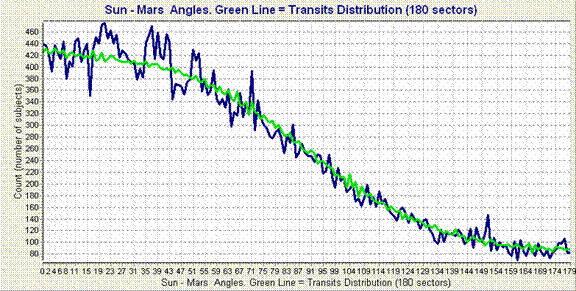 The blue line is the distribution for 46,257 charts of people, companies, and events. Very interestingly the relatively smooth green line as compare to the blue line in this graph reveals more fluctuation in Sun-Mars angles for the charts of people than in the daily distribution even though the number of charts of people and the number of daily charts in the random distribution is about the same. Because the charts of people, companies, and events covers a very wide range of phenomena, we can guess that this greater variability in the distribution of Sun-Mars angles in these charts is due to a greater number of scores in certain years or seasons. Because this issue is not the primary concern of this paper, we will not pursue this issue further. The main point in regards to the current study is that there is greater tendency for Sun to be near Mars than to be far from Mars. In the graphs shown in Figure 2 the distribution of Mars in 120 Gauquelin sectors is given, and the sectors are numbered 1 to 120. By dividing the angles given by Landscheidt by three we obtain the equivalent sector number in the graphs below. The peaks identified by Landsheidt and given earlier in this paper are divided by three to show the equivalent sector number in Data Summary 2 below. Data Summary 2.
In addition to the complexity of analyzing the day chart and night chart distributions of Mars in Gauquelin sectors due to the fact that the Sun and Mars tend to be near each other in a random distribution is the diurnal distribution of births. In studies of diurnal birth patterns one finding is, for example, that natural births occur most often a few hours before sunrise but births involving intervention tend to occur during weekday office hours. Because the Sun and Mars are four times more likely to be conjunct than opposition (see Figure 1) and births do not occur uniformly throughout the day, there is a tendency for Mars to more often be in the direction of the Sun. As expected as a consequence of these two relationships, in Figure 2 we see that, as expected, the Sun is more likely above the horizon (in the first half of the Gauquelin sectors) for day births and in below the horizon for night births. A detailed analysis of the diurnal distribution of the Sun and the consequent diurnal random distribution of Mars as a result of Mars more often being near the Sun could be used to adjust the graphs in Figure 2 to correct for a kind of bias based on the greater likelihood of the Sun and Mars being near each other and the tendency for births to occur during certain times of the day. This analysis would be imperfect at best and a clear and unambiguous deviation from the random distribution would be necessary to draw unequivocal conclusions regarding the distribution of Mars in Gauquelin sectors for day births and night births of the various professional groups. The graphs shown below in Figure 2 suggest that an unambiguous conclusion of this kind is unlikely. In many cases, the day charts and night charts appear to confirm each other. For example, in the first graph for painters we see a peak between the 26th and 29th sectors in both the day (green line) charts and the night (blue line) charts. Because the night charts are less likely to have Mars in the first half of the Gauquelin sectors (Mars above the horizon) because the Sun and Mars are more often near each other (and in a night chart, by definition, the Sun is below the horizon), the peak between the 26th and 29th sectors for night charts may not appear to be as conspicuous as it actually is when corrected for the random tendency of Mars to be below the horizon in night charts. The 28th sector is equivalent to 84 degrees (28 x 3) which is near 82.9 degrees, and does not happen to be one of the points identified by Landscheidt as a high point or low point for any of the professional groups. A researcher may, however, wish to study the nine graphs in Figure 2 to see if any consistent patterns appear to emerge.   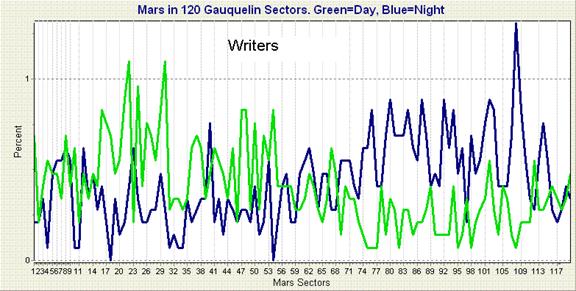 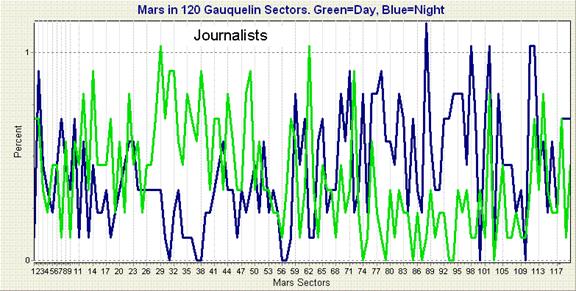 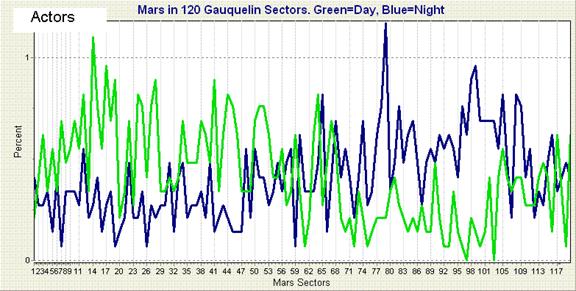 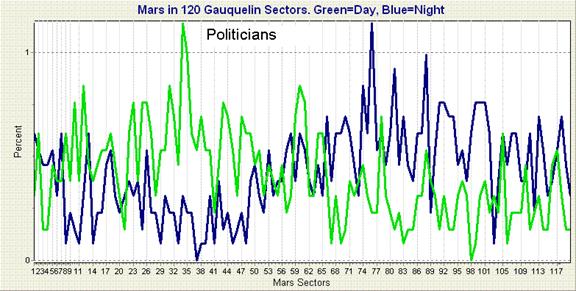 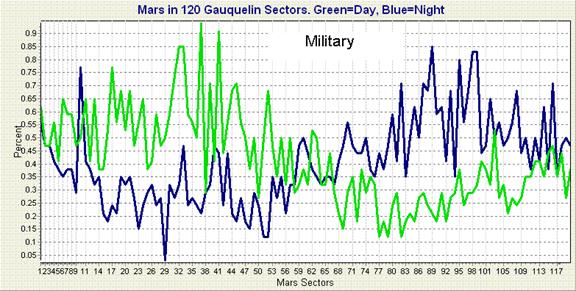 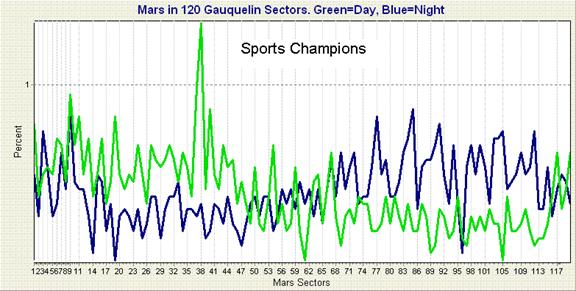 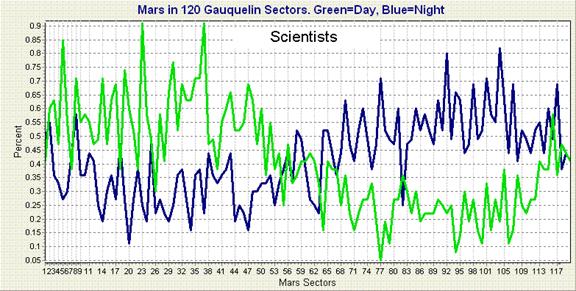 ConclusionsAstrology is a highly controversial subject, as is evident from the heated debates from astrological researchers and skeptics that occurred in the past. Astrologers tended to see Gauquelin's findings as significant and skeptics tended to find serious flaws in the research that prevents any solid conclusions in support of astrological theory. Both camps evidently saw what they wanted to see. Many sociologists, anthropologists, and other researchers who specialize in qualitative methods emphasize that scientific pursuits are never completely objective and free of the personal perspective that the researcher invests into the research project. I suggest that research is best conducted by people who are hopeful of finding positive results. If medical researchers seeking a cure for cancer felt certain that a cure would not be found and the undertaking was nonsense, then I think that most people, myself included, would feel that the precious resources invested into this research would be better spent if the researchers had more positive feelings about the research. In this study of Landscheidt's research and the Gauquelin it is my hope that Landscheidt's theories would be clearly supported. However, the findings are not as positive as hoped for. On the other hand, the results are also not surprising. In other research studies in this series of studies posted on this website are some much more promising findings than was obtained in this study. In addition to conducting research with the hope of obtaining positive findings, another motivation behind this research is to address any serious study which suggests that astrology may have measurable results. Landscheidt's work is extraordinarily unusual within the field of astrology in that he employs sophisticated models that are founded in relationships to cutting edge theory in mathematics and physics, he meticulously gathers data, and obtains seemingly stunning results. Conducting research nearly by oneself with few other intellectual or material resources is a daunting task, and Theodor Landscheidt is highly unusual in having succeeded in achieving so much through his own efforts. Although the current study and other studies that I have conducted to reanalyze Landscheidt's findings have produced largely negative results, nevertheless Landscheidt succeeded in pioneering new pathways and insights that is taking us decades to thoroughly and comprehensively evaluate. Even if negative findings are obtained, we are advancing our understanding of the limits and potential of new technologies and theoretical systems that are very important to consider. The dream of Landscheidt is not dead. As suggested in other studies in this series, there are studies that suggest that cosmic cybernetics is capable of producing measurable and consistent results. We are still in the stage of infancy in trying to establish basic principles for this new discipline and along the way we can expect to obtain negative results in many studies, but also hopefully sometimes positive results that will eventually lead to solid ground for the birth of cosmic cybernetics as a sound, useful, and productive discipline.
|

 AUTHOR:
AUTHOR: 